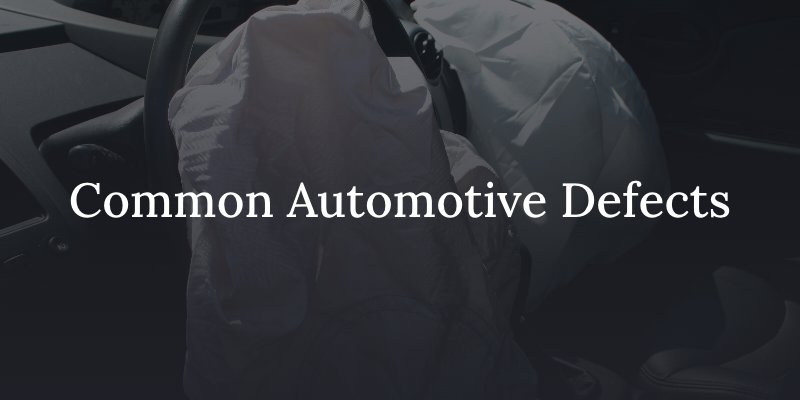When car accidents occur, we typically look toward driver error as the cause, since a driver’s negligence or recklessness is the most common cause of traffic-related accidents, such as a driver failing to yield the right of way at an intersection. But what if an accident’s cause was purely mechanical? Suppose the driver who failed to yield the right of way tried to stop but their car’s brakes failed. Car accidents caused by dangerous automotive defects are not as uncommon as you’d think. In fact, defective automobile components are one of the most common defective product claims. Sometimes an investigation into a car accident reveals that a defective car component caused the accident, but where does an injury victim go from there?
Common Vehicle Defects in Product Liability Claims
Some vehicle defects cause accidents and others increase the chances of injuries in a car accident. When someone is harmed in an accident caused by an automotive defect, it’s typically due to either an inherent defect in the product’s design, an error in manufacturing, or a marketing mistake that failed to add sufficient usage, care, or warning instructions. There is an official government tool to look up if your car has a current recall, but individual and isolated cases of defects are common as well. Common vehicle component defects in automotive product liability claims include the following:
- Airbag defects: some airbags have sent shrapnel propelling into the car at high speed, injuring or killing vehicle occupants. Airbags may also fail to deploy, deploy without an accident, or deploy too forcefully, causing injuries.
- Seatbelt defects: when a seatbelt doesn’t snap quickly into place or unlatches during a collision, the result can be deadly.
- Tire defects: defective tires can cause blowouts, loss of vehicle control, and serious accidents.
- Accelerator defects: when a car’s accelerator sticks, drivers may be unable to control the car’s speed, placing occupants in an emergency situation.
- Door latch defects: when a car’s doors do not latch shut correctly, a door may open in traffic or at high speed, causing an accident, or a passenger may be expelled from the vehicle.
- Ignition defects: when a vehicle’s ignition turns off in traffic or on a highway, the driver may lose control of the vehicle’s steering with deadly consequences.
- Light defects: If a car’s headlights flicker or turn off unexpectedly, the result could be a collision or roadway departure due to a sudden inability to see. Likewise, defective tail lights may result in rear-end collisions. Tractor-trailer light defects result in collisions in intersections when other drivers cannot see the trailer behind a commercial truck.
- Brake defects: If a car’s brakes suddenly become inoperable or unreliable, the result could be a serious accident and injuries.
- Steering defects: An inability to steer a vehicle makes control impossible, resulting in collisions and roadway departures with serious injuries.
These and other mechanical failures due to defective automotive parts are some of the most dangerous defective product incidents, sometimes causing injuries and fatalities not only to the occupants of the defective vehicle but to other vehicles sharing the roadway with a car with a defective automotive part.
Recovering Compensation After an Automotive Defect Accident
After an accident, the injury victim’s car accident attorney and the insurance adjusters investigate the accident to determine the cause of the accident and the liable party. In some cases, the investigation shows that the accident occurred due to a defective part. The accident claim becomes a defective product claim against the manufacturer. Manufacturers have strict liability when they produce a product that causes injury. Injury victims do not have to prove negligence in a defective product claim.
A successful defective product claim after an accident results in compensation for damages like medical expenses, lost wages, and pain and suffering. Our Kansas City injury attorney can guide you through this process and ensure you earn your rightful compensation.


